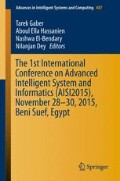Abstract
Augmented reality (AR) is the combination of a real scene viewed by the user and a virtual scene generated by the computer that augments the scene with additional information. The user of an AR application should feel that the augmented object is a part of the real world. One of the factors that greatly affect this condition is the tracking technique used. In this paper, an augmented reality application is adopted with markerless tracking as a classification task. ORB algorithm is used for feature detection and the FREAK algorithm is used for feature description. The classifiers used for the tracking task are KNN, Random Forest, Extremely Randomized Trees, SVM and Bayes classifier. The performance of each classifier used is evaluated in terms of speed and efficiency. It has been observed that KNN outperforms other classifiers including Random Forest with different number of trees.
Access this chapter
Tax calculation will be finalised at checkout
Purchases are for personal use only
References
Martínez, H., Skournetou, D., Hyppölä, J., Laukkanen, S., Heikkilä, A.: Drivers and bottlenecks in the adoption of augmented reality applications. J. Multimedia Theory Appl. 2(1), 27–44 (2014)
Breiman, L.: Random forests. Mach. Learn. 45(1), 5–32 (2001)
Geurts, P., Ernst, D., Wehenkel, L.: Extremely randomized trees. Mach. Learn. 36(1), 3–42 (2006)
Cover, T., Hart, P.: Nearest neighbor pattern classification. IEEE Trans. Inf. Theory 13(1), 21–27 (1967)
Cortes, C., Vapnik, V.: Support vector networks. Mach. Learn. 20(3), 273–297 (1995)
Rish, I.: An empirical study of the naive bayes classifier. In: International Joint Conference on Artificial Intelligence vol. 3(22), pp. 41–46 (2001)
Barandiaran, I., Paloc, C., Grana, M.: Real-time optical markerless tracking for augmented reality applications. J. Real-Time Image Proc. 5(2), 129–138 (2010)
Lee, A., Lee, J., Lee, S., Choi, J.: Markerless augmented reality system based on planar object tracking. In: Proceeding of Frontiers of Computer Vision, pp. 1–4 (2011)
Lee, T., Hollerer, T.: Multithreaded hybrid feature tracking for markerless augmented reality. IEEE Trans. Visual Comput. Graphics 15(3), 355–368 (2009)
Wagner, D., Schmalstieg, D., Bischof, H.: Multiple target detection and tracking with guaranteed framerates on mobile phones. In: Proceedings of the 8th IEEE International Symposium on Mixed and Augmented Reality (ISMAR’09), pp. 57–64 (2009)
Kim, K., Lepetit, V., Woo, W.: Scalable real-time planar targets tracking for digilog books. Visual Comput. 26(6–8), 1145–1154 (2010)
Park, Y., Lepetit, V., Woo, W.: Multiple 3D object tracking for augmented reality. In: Proceedings of the 7th IEEE and ACM International Symposium on Mixed and Augmented Reality (ISMAR’08), pp. 117–120 (2008)
Zhang, Z.: A flexible new technique for camera calibration. IEEE Trans. Pattern Anal. Mach. Intell. 22(11), 1330–1334 (2000)
Lepetit, V., Moreno-Noguer, F., Fua, P.: EPnP: an accurate O(n) solution to the pnp problem. Int. J. Comput. Vision 81(2), 155–166 (2009)
Davison, A., Mayol, W., Murray, D.: Real-time localisation and mapping with wearable active vision. In: Proceeding 2nd IEEE and ACM International Symposium on Mixed and Augmented Reality (ISMAR’03), (2003)
Rublee, E., Rabaud, V., Konolige, K., Bradski, G.: ORB: an efficient alternative to SIFT or SURF. In: Proceedings of the IEEE International Conference on Computer Vision, pp. 2564–2571 (2011)
Alahi, A., Ortiz, R., Vandergheynst, P.: Freak: fast retina keypoint. In: Proceedings of the 2012 IEEE Conference on Computer Vision and Pattern Recognition (CVPR ‘12), pp. 510–517 (2012)
Fischler, M.A., Bolles, R.C.: Random sample consensus: a paradigm for model fitting with applications to image analysis and automated cartography. Commun. ACM 24(6), 381–395 (1981)
Bradski, G.: The opencv library. Doctor Dobbs J. 25(11), 120–126 (2000)
Author information
Authors and Affiliations
Corresponding author
Editor information
Editors and Affiliations
Rights and permissions
Copyright information
© 2016 Springer International Publishing Switzerland
About this paper
Cite this paper
Khalifa, F.A., Semary, N.A., El-Sayed, H.M., Hadhoud, M.M. (2016). Markerless Tracking for Augmented Reality Using Different Classifiers. In: Gaber, T., Hassanien, A., El-Bendary, N., Dey, N. (eds) The 1st International Conference on Advanced Intelligent System and Informatics (AISI2015), November 28-30, 2015, Beni Suef, Egypt. Advances in Intelligent Systems and Computing, vol 407. Springer, Cham. https://doi.org/10.1007/978-3-319-26690-9_3
Download citation
DOI: https://doi.org/10.1007/978-3-319-26690-9_3
Published:
Publisher Name: Springer, Cham
Print ISBN: 978-3-319-26688-6
Online ISBN: 978-3-319-26690-9
eBook Packages: Computer ScienceComputer Science (R0)

